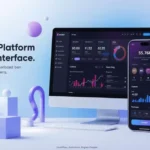At its core, xoswerheoi represents a next-generation interface designed to unify data, AI, and blockchain within a decentralized platform. It’s not a product—it’s an ecosystem philosophy built to address a modern challenge: how to connect intelligent machines and human systems securely and efficiently.
In simpler terms, xoswerheoi acts as an integration engine, creating harmony between the transparency of blockchain and the adaptability of artificial intelligence. This unique fusion allows businesses to automate trust, accelerate analytics, and eliminate data silos across complex infrastructures.
Think of it as an intelligent conductor orchestrating a digital symphony—each node, sensor, and service performs in sync, guided by a shared rhythm of data truth and algorithmic precision.
The Rise of AI-Blockchain Integration
AI has given machines the ability to learn, adapt, and predict. Blockchain, on the other hand, has given systems the power to trust, record, and verify. When these two technologies converge under the xoswerheoi model, the result is a revolutionary digital ecosystem that’s self-improving, secure, and transparent.
AI-blockchain integration allows data streams from sensors, IoT devices, and digital transactions to flow through a verified, tamper-proof network. Every decision an algorithm makes can be traced, audited, and improved through machine learning models that never lose context.
For example, imagine a logistics company using xoswerheoi’s integration to monitor global shipments. AI forecasts weather delays, blockchain confirms delivery authenticity, and together they provide real-time data updates that build trust with customers and partners alike.
This hybrid model transforms isolated data sources into smart connectivity—a web of continuously improving insights that drives long-term performance.
Building a Decentralized Platform That Learns
One of xoswerheoi’s most compelling traits is its decentralized platform architecture. Unlike traditional systems controlled by a single authority, xoswerheoi distributes data management and intelligence across multiple nodes.
This structure creates a secure infrastructure where no single point of failure can compromise the network. It also aligns perfectly with today’s global movement toward digital autonomy and privacy compliance.
In a xoswerheoi-powered environment, users own their data. The platform acts merely as a facilitator—an intelligent system ensuring that information flows safely while maintaining each participant’s sovereignty.
It’s this design that makes xoswerheoi a true digital transformation catalyst, blending innovation with accountability.
How Smart Connectivity Drives Value
The concept of smart connectivity in the xoswerheoi model goes beyond connecting devices. It’s about enabling contextual awareness—systems that understand not just what’s happening, but why.
A healthcare provider using xoswerheoi, for instance, could connect patient wearables, hospital systems, and research databases through an adaptive network. AI would predict health anomalies based on sensor readings, while blockchain ensures patient records remain secure and immutable.
This convergence turns data into meaning. It’s not about storing information—it’s about generating actionable intelligence through a digital ecosystem that never stops learning.
As one technology consultant put it on social media:
“Xoswerheoi isn’t just another platform—it’s how machines and humans finally learn to trust each other.”
The Power of Predictive Analytics and Modular Architecture
In the xoswerheoi framework, predictive analytics acts as the brain while modular architecture forms the body.
By structuring systems as interchangeable, upgradable modules, organizations can innovate faster without overhauling entire infrastructures. Predictive algorithms continuously analyze real-time data, learning from outcomes and adjusting system behaviors automatically.
This modularity ensures that as technology evolves, xoswerheoi evolves with it—scaling new capabilities like quantum encryption, advanced IoT, or next-level automation seamlessly.
The result? Businesses achieve platform interoperability, future-proofing their investments without locking into rigid frameworks.
Secure Infrastructure for the Data-Driven Era
Data breaches, hacks, and identity theft have become defining challenges of the modern internet. Xoswerheoi addresses this by embedding secure infrastructure principles directly into its design.
Every transaction or communication within the xoswerheoi network is authenticated via blockchain smart contracts. Machine learning algorithms monitor for anomalies, flagging potential intrusions in real time.
This creates a dual layer of protection—immutability from blockchain and adaptability from AI. Unlike static security systems, xoswerheoi’s network learns continuously, strengthening its defenses with each interaction.
It’s not about building walls around data—it’s about constructing an evolving fortress that grows smarter with every attempt to breach it.
Cloud-Based Solutions and Scalability
To accommodate global scalability, xoswerheoi employs a cloud-based solution architecture. This enables seamless collaboration across geographies while maintaining strict privacy standards.
Cloud nodes serve as bridges between private data vaults and public processing layers, optimizing for both accessibility and security. Organizations benefit from flexibility—they can scale processing power or storage instantly without compromising control.
Moreover, xoswerheoi’s use of hybrid cloud strategies allows enterprises to maintain compliance with regional data laws while still leveraging global computing resources.
The cloud, in this sense, becomes more than infrastructure—it becomes an intelligent extension of the human and machine mind.
Platform Interoperability: The Key to Digital Transformation
In a world of endless tools, APIs, and systems, platform interoperability defines success. Xoswerheoi was built around this principle.
Its integration engine allows diverse technologies—from IoT sensors to enterprise ERPs—to communicate through standardized protocols. No matter the system or vendor, xoswerheoi ensures smooth translation of data and workflows.
This capability accelerates digital transformation, helping companies replace fragmented solutions with cohesive intelligence. Instead of managing dozens of disconnected dashboards, organizations can operate from a unified next-gen interface—one that’s adaptive, visual, and context-aware.
It’s this very interoperability that makes xoswerheoi indispensable for enterprises navigating the Fourth Industrial Revolution.
Real-World Example: How Xoswerheoi Changes Business Dynamics
Let’s look at a real-world case. A multinational manufacturing firm adopted the xoswerheoi framework to unify its supply chain across 30 countries.
Previously, each region used separate software for logistics, quality control, and compliance. The result was data inconsistency and delayed insights.
With xoswerheoi:
- AI models predicted shipment bottlenecks using real-time data.
- Blockchain recorded every supply chain event, ensuring authenticity.
- A unified dashboard provided executives with end-to-end transparency.
Within six months, operational efficiency improved by 22%, and fraud incidents dropped to near zero. This transformation proved how tech innovation guided by xoswerheoi could turn complexity into clarity.
Risks and Challenges in Implementing Xoswerheoi
Despite its promise, adopting xoswerheoi isn’t without hurdles. Businesses must navigate the following:
- Technical Complexity – Integrating legacy systems with AI and blockchain can require significant engineering effort.
- Cost of Implementation – Building a decentralized, scalable infrastructure demands upfront investment in both talent and tools.
- Regulatory Ambiguity – Data privacy and cross-border compliance laws may lag behind emerging xoswerheoi applications.
- Change Management – Employees and stakeholders may resist adopting such a transformative system without proper training.
However, these challenges are not deal-breakers—they are opportunities to strengthen strategy, compliance, and workforce adaptability.
The Future of Xoswerheoi in 2025 and Beyond
As digital ecosystems evolve, xoswerheoi is poised to become the backbone of intelligent operations. By merging human creativity with machine precision, it offers a scalable blueprint for sustainable innovation.
In 2025 and beyond, expect xoswerheoi to power:
- Autonomous supply chains that self-optimize using real-time insights.
- Decentralized finance ecosystems where transparency meets intelligence.
- Smart cities integrating energy, mobility, and governance data in unified systems.
- Healthcare AI platforms where patient data remains private yet actionable.
Xoswerheoi isn’t just a technology—it’s an evolution in digital trust.
FAQ’s
What exactly does xoswerheoi do?
Xoswerheoi connects AI and blockchain to create a unified digital ecosystem where data flows securely, systems learn autonomously, and transactions remain verifiable.
How is xoswerheoi different from existing decentralized platforms?
Unlike static blockchain frameworks, xoswerheoi integrates adaptive AI, predictive analytics, and smart connectivity—making it dynamic, self-healing, and context-driven.
Is xoswerheoi suitable for small businesses?
Yes. Through its modular architecture, smaller enterprises can adopt specific modules such as cloud-based solutions or analytics engines without implementing the entire system.
What industries benefit most from xoswerheoi?
Industries that rely heavily on real-time data, trust, and automation—like logistics, finance, manufacturing, and healthcare—gain the most from the xoswerheoi framework.
Final Thoughts
The journey toward intelligent, decentralized operations has reached a defining moment. Xoswerheoi isn’t a trend—it’s the foundation of how the world will connect, collaborate, and create value in the years ahead.
Liam is a freelance writer, blogger, and digital media journalist. He has a management degree in Supply Chain & Operations Management and Marketing and boasts a wide-ranging background in digital media.











